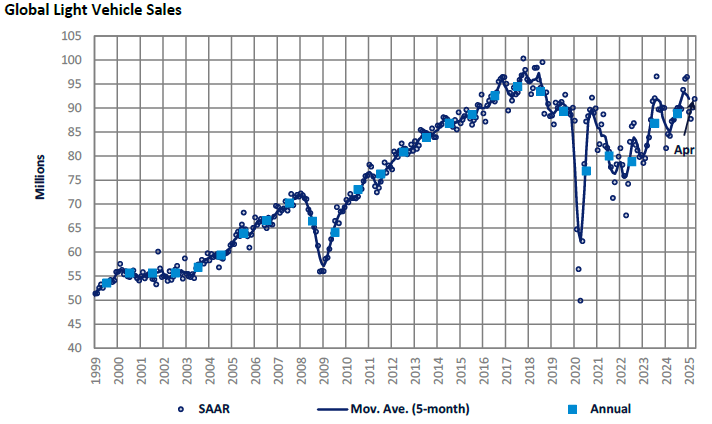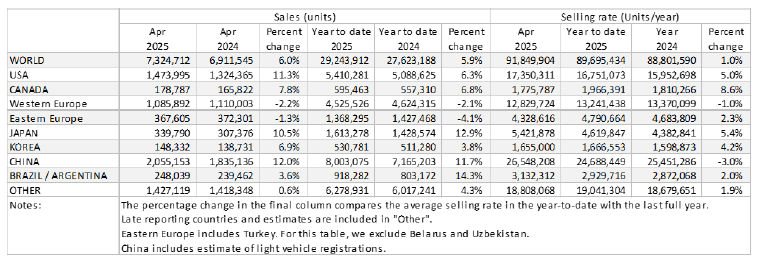For April, the Global Light Vehicle (LV) selling rate is estimated to be 92 million units/year, building on the improvement seen in March. In year-on-year (YoY) terms, the market saw another strong month of growth, with sales up 6% to 7.3 million units.

Both China and the US demonstrated a strong performance, YoY, while Western Europe continues to face challenges. In the US, the momentum from the pull-forward effect observed in March persisted, contributing to another impressive sales figure in April. Meanwhile, in China, sales have remained stable, buoyed by government stimulus measures. Conversely, Western Europe experienced a decline in sales, as EU consumer confidence plummeted to its lowest level in the past 17 months.

North America
US Light Vehicle sales grew by 11.3% YoY in April, to 1.47 million units, and increasing by 7.0% YoY on a selling day-adjusted basis. The annualized selling rate eased to 17.4 million units/year in April, from 17.8 million units/year in March. The pull-forward effect first noted in March – when consumers rushed to make purchases ahead of potential tariff-related price rises – was still present in April, but the pace of sales appeared to weaken later in the month. This could be a sign that the initial surge has ended, while average transaction prices are already rising, to US$46,054 in April, up by US$1,177 YoY, even without the full impact of tariffs being in effect.
In Canada, sales reached 179k units in April, growing by 7.8% YoY. However, the selling rate slowed to 1.78 million units/year in April, down from 2.05 million units/year in March, and the lowest rate since August 2024. Similar dynamics were observed in Canada as in the US, with consumers incentivized to buy now rather than wait and face possible price rises. Mexican LV sales totaled 116k units in April, up by 2.8% YoY. The selling rate for April was broadly in line with the previous month. Mexico has not retaliated with tariffs on vehicles imported from the US, and any economic impact from the trade war is yet to be felt.
Europe

US Tariffs are shifting - will you react or anticipate?
Don’t let policy changes catch you off guard. Stay proactive with real-time data and expert analysis.
By GlobalDataThe LV selling rate for Western Europe rose slightly to 12.8 million units in April. In YoY terms, the market was down over 2%. YTD LV sales are now down 2% as well. The region is currently experiencing several economic challenges. Growth has stagnated in major markets such as Germany and France. Furthermore, consumer confidence has dropped to its lowest point since November 2023, highlighting the prevailing concerns about the region’s economic outlook.
In Eastern Europe, the LV selling rate rose to 4.3 million units in April. Sales were down a modest 1% YoY, a relatively better result in comparison to the weak results seen in the previous two months. The Russian LV market saw a 26% YoY decline despite a 16% increase in the selling rate. Aggressive discounting temporarily boosted sales while high-interest rates and fading consumer hopes for the return of Western brands contributed to postponed purchases, prompting calls for state intervention to support the auto industry. LV sales in Turkey continue to thrive, with consumers continuing to turn to vehicles as a safeguard against rampant inflation.
China
In April, Chinese LV sales are estimated to have grown by 12%, YoY, to around 2.1 million vehicles. In particular, PV sales reached 1.8 million in April, up 12.5% YoY, totaling 24 million units/year on a seasonally adjusted basis. YTD sales have now increased 12.2% YoY, totaling 7 million units in four months. The PV sales performance has been supported by government subsidies — this year, the government extended its vehicle trade-in scrappage incentive scheme to the end of 2025 boosting the auto market’s domestic demand, mostly for new energy vehicles (NEVs), while also helping reducing purchase restrictions.
The US-Chinese trade negotiations reached a temporary conclusion as tariff rates were mutually dropped until August 10th, offering some relief to China’s huge export market. Demand for Chinese trade has been dropping amidst the uncertainty.
In Japan, LV sales increased YoY by a double-digit percentage for the fourth month in a row in April, due to the low-base comparison to the sales a year ago, when vehicle testing irregularities issues hit the vehicle production/sales. In April, the selling rate turned to a sharp increase to 5.4 million units, up 44% from March 2025. As the negative impact of an accident at the plant of Chuo Spring (which led to recent weak sales figures) has been solved, Daihatsu and Suzuki vehicle supply has normalized in April. Additionally, OEMs are solving back orders by increasing vehicle supply.
Korean LV sales maintained growth momentum on a SAAR basis, with PVs driving topline sales. April’s raw data showed LV sales expanding 7% YoY, improving on March (2% YoY), supported by new pickup truck launches. Both local model sales (7% YoY) and import sales (4% YoY) posted positive sales growth for the third consecutive month.
South America
Brazilian Light Vehicle sales reached 197k units in April, falling by 5.4% YoY. However, the selling rate increased to 2.47 million units/year in April, from 2.41 million units/year in March. As Easter fell in April this year, as opposed to March in 2024, volumes likely suffered due to selling days being lost. Still, the selling rate was the highest of the year to date. For now, the market continues to hold up well, despite rising interest rates, helped by an increasing influence of Chinese OEMs.
In Argentina, sales surged to just under 51k units in April, up by 63.3% YoY. While the market has consistently achieved large YoY gains over the first four months of 2025, April saw comfortably the strongest selling rate of the year so far, at 664k units/year. Indeed, this was the highest rate since August 2018. A recent reduction in taxes on many vehicles, combined with more models being imported and a growing economy, has significantly boosted sales.

This article was first published on GlobalData’s dedicated research platform, the Automotive Intelligence Center.




